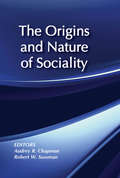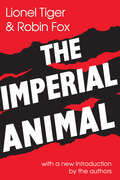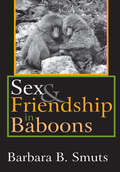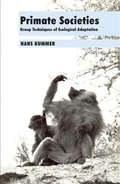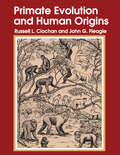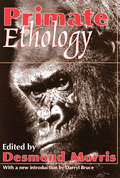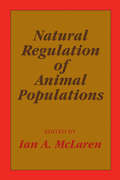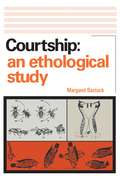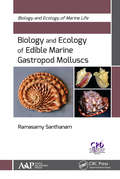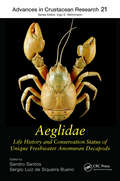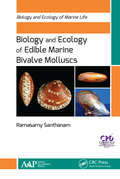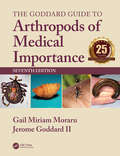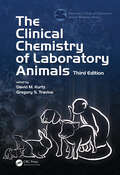- Table View
- List View
The Origins and Nature of Sociality
by Robert W. SussmanScientific developments have increasingly been transforming our understanding of the place of human beings in nature. The contributors to this book focus on the current status of research on sociality and the evolution of cooperative and altruistic behaviour in non-human and human primates. They examine questions related to the evolution, cultural viability, and hormonal underpinnings of human sociality in specific detail, and describe patterns of sociality that shed light on human social behaviour.
The Origins and Nature of Sociality
by Robert W. SussmanScientific developments have increasingly been transforming our understanding of the place of human beings in nature. The contributors to this book focus on the current status of research on sociality and the evolution of cooperative and altruistic behaviour in non-human and human primates. They examine questions related to the evolution, cultural viability, and hormonal underpinnings of human sociality in specific detail, and describe patterns of sociality that shed light on human social behaviour.
The Imperial Animal (Owl Bks.)
by Lionel Tiger Robin FoxThe Imperial Animal offers a compelling perspective on the controversy over humans and their biology. This now-classic study is about the social bonds that hold us together and the antisocial theories that drive us apart. The authors divulge how the evolutionary past of the species, reflected in genetic codes, determines our present and coerces our future. This book gives us a direct and intimate look at how we see ourselves. It offers insight into our politics, our ways of learning and teaching, reproducing and producing, playing and fighting.The authors assert that the purpose of this book is twofold: to describe what is known about the evolution of human behavior, and then to try to show how the consequences of this evolution affect our behavior today. To do this they draw from numerous disciplines—zoology, biology, history, and primatology, among others. In the new introduction, Tiger and Fox outline then- reasons for originally writing the book as well as the process they used to do their research. The Imperial Animal is a classic work that will continue to be of interest to sociologists, zoologists, biologists, and primatologists.
The Imperial Animal
by R. Robin MillerThe Imperial Animal offers a compelling perspective on the controversy over humans and their biology. This now-classic study is about the social bonds that hold us together and the antisocial theories that drive us apart. The authors divulge how the evolutionary past of the species, reflected in genetic codes, determines our present and coerces our future. This book gives us a direct and intimate look at how we see ourselves. It offers insight into our politics, our ways of learning and teaching, reproducing and producing, playing and fighting.The authors assert that the purpose of this book is twofold: to describe what is known about the evolution of human behavior, and then to try to show how the consequences of this evolution affect our behavior today. To do this they draw from numerous disciplines—zoology, biology, history, and primatology, among others. In the new introduction, Tiger and Fox outline then- reasons for originally writing the book as well as the process they used to do their research. The Imperial Animal is a classic work that will continue to be of interest to sociologists, zoologists, biologists, and primatologists.
Sex and Friendship in Baboons (Evolutionary Foundations Of Human Behavior Ser.)
by Barbara B. SmutsThose who have been privileged to watch baboons long enough to know them as individuals and who have learned to interpret some of their more subtle interactions will attest that the rapid flow of baboon behavior can at times be overwhelming. In fact, some of the most sophisticated and influential observation methods for sampling vertebrate social behavior grew out of baboon studies, invented by scientists who were trying to cope with the intricacies of baboon behavior. Barbara Smuts' eloquent study of baboons reveals a new depth to their behavior and extends the theories needed to account for it.While adhering to the most scrupulous methodological strictures, the author maintains an open research strategy--respecting her subjects by approaching them with the open mind of an ethnographer and immersing herself in the complexities of baboon social life before formulating her research design, allowing her to detect and document a new level of subtlety in their behavior. At the Gilgil site, described in this book, she could stroll and sit within a few feet of her subjects. By maintaining such proximity she was able to watch and listen to intimate exchanges within the troop; she was able, in other words, to shift the baboons well along the continuum from ""subject"" to ""informant."" By doing so she has illuminated new networks of special relationships in baboons. This empirical contribution accompanies theoretical insights that not only help to explain many of the inconsistencies of previous studies but also provide the foundation for a whole new dimension in the study of primate behavior: analysis oft he dynamics of long-term, intimate relationships and their evolutionary significance.At every stage of research human observers have underestimated the baboon. These intelligent, curious, emotional, and long-lived creatures are capable of employing stratagems and forming relationships that are not easily detected by traditional research methods. In the process
Sex and Friendship in Baboons
by Barbara B. SmutsThose who have been privileged to watch baboons long enough to know them as individuals and who have learned to interpret some of their more subtle interactions will attest that the rapid flow of baboon behavior can at times be overwhelming. In fact, some of the most sophisticated and influential observation methods for sampling vertebrate social behavior grew out of baboon studies, invented by scientists who were trying to cope with the intricacies of baboon behavior. Barbara Smuts' eloquent study of baboons reveals a new depth to their behavior and extends the theories needed to account for it.While adhering to the most scrupulous methodological strictures, the author maintains an open research strategy--respecting her subjects by approaching them with the open mind of an ethnographer and immersing herself in the complexities of baboon social life before formulating her research design, allowing her to detect and document a new level of subtlety in their behavior. At the Gilgil site, described in this book, she could stroll and sit within a few feet of her subjects. By maintaining such proximity she was able to watch and listen to intimate exchanges within the troop; she was able, in other words, to shift the baboons well along the continuum from ""subject"" to ""informant."" By doing so she has illuminated new networks of special relationships in baboons. This empirical contribution accompanies theoretical insights that not only help to explain many of the inconsistencies of previous studies but also provide the foundation for a whole new dimension in the study of primate behavior: analysis oft he dynamics of long-term, intimate relationships and their evolutionary significance.At every stage of research human observers have underestimated the baboon. These intelligent, curious, emotional, and long-lived creatures are capable of employing stratagems and forming relationships that are not easily detected by traditional research methods. In the process
Primate Societies: Group Techniques of Ecological Adaptation (Worlds Of Man Ser.)
by Hans KummerIn this book, Hans Kummer, one of the world's leading primate ethologists, examines the patterns of social interaction among primates. He examines this social behavior from the fundamentally biological viewpoint of evolutionary adaptation as part of the survival mechanisms for the species. Recognizing that all activity is constituted in part of genetic programming and in part of adaptive behavior, he explores the borderline area between the genetic and the "cultural." By use of astute observation and clever experimentation he shows that many aspects of social behavior are inherited, and differentially inherited among various primate groups. These data also show, however, that the individuals and troops learn much in primate social life and that these forms are responsive to particular ecological situations. Drawing heavily on knowledge gleaned from his own well-known studies of the Hamadryas baboon, Dr. Kummer introduces the reader to the daily life of a particular primate society. From this sample case, he proceeds to a more general characterization of primate societies, using as examples the great apes and monkeys of Africa, Asia, and South America and particularly the widely studied terrestrial monkey species. The particularities of primate communication, social structure, and economy are described and special attention is devoted to the primate counterparts of kinship and age groups-behavioral differences based on age and sex, and mating and grouping systems. This is followed by a chapter dealing with the ecological functions of the major parameters of primate social life, such as group size and the coordination of activities within it-dominance, leadership systems, and spatial arrangements. The second part of the book is concerned with the origins of behavioral traits of primates, discussed from phylogenetic, ecological, and cultural points of view, again using data-based examples. Dr. Kummer explains why some traits have not evolved that would have been ada
Primate Societies: Group Techniques of Ecological Adaptation
by Hans KummerIn this book, Hans Kummer, one of the world's leading primate ethologists, examines the patterns of social interaction among primates. He examines this social behavior from the fundamentally biological viewpoint of evolutionary adaptation as part of the survival mechanisms for the species. Recognizing that all activity is constituted in part of genetic programming and in part of adaptive behavior, he explores the borderline area between the genetic and the "cultural." By use of astute observation and clever experimentation he shows that many aspects of social behavior are inherited, and differentially inherited among various primate groups. These data also show, however, that the individuals and troops learn much in primate social life and that these forms are responsive to particular ecological situations. Drawing heavily on knowledge gleaned from his own well-known studies of the Hamadryas baboon, Dr. Kummer introduces the reader to the daily life of a particular primate society. From this sample case, he proceeds to a more general characterization of primate societies, using as examples the great apes and monkeys of Africa, Asia, and South America and particularly the widely studied terrestrial monkey species. The particularities of primate communication, social structure, and economy are described and special attention is devoted to the primate counterparts of kinship and age groups-behavioral differences based on age and sex, and mating and grouping systems. This is followed by a chapter dealing with the ecological functions of the major parameters of primate social life, such as group size and the coordination of activities within it-dominance, leadership systems, and spatial arrangements. The second part of the book is concerned with the origins of behavioral traits of primates, discussed from phylogenetic, ecological, and cultural points of view, again using data-based examples. Dr. Kummer explains why some traits have not evolved that would have been ada
Primate Evolution and Human Origins
by Russell L. CiochonPrimate Evolution and Human Origins compiles, for the first time, the major ideas and publications that have shaped our current view of the evolutionary biology of the primates and the origin of the human line. Designed for freshmen-to-graduate students in anthropology, paleontology, and biology, the book is a unique collection of classic papers, culled from the past 20 years of research. It is also an important reference for academicians and researchers, as it covers the entire scope of primate and human evolution (with an emphasis on the fossil record). A comprehensive bibliography cites over 2000 significant articles not found in the main text.
Primate Evolution and Human Origins
by Russell L. CiochonPrimate Evolution and Human Origins compiles, for the first time, the major ideas and publications that have shaped our current view of the evolutionary biology of the primates and the origin of the human line. Designed for freshmen-to-graduate students in anthropology, paleontology, and biology, the book is a unique collection of classic papers, culled from the past 20 years of research. It is also an important reference for academicians and researchers, as it covers the entire scope of primate and human evolution (with an emphasis on the fossil record). A comprehensive bibliography cites over 2000 significant articles not found in the main text.
Primate Ethology
by Pendleton HerringThis is a groundbreaking workwhich brought together studiesof monkeys and apes from boththe laboratory and the field. Manybroad aspects of primate life,including facial expressions,sexual signals, grooming, play,social organization and parental care, are covered bythe contributors and provided a whole new approach toprimate behavior.
Primate Ethology
by Pendleton HerringThis is a groundbreaking workwhich brought together studiesof monkeys and apes from boththe laboratory and the field. Manybroad aspects of primate life,including facial expressions,sexual signals, grooming, play,social organization and parental care, are covered bythe contributors and provided a whole new approach toprimate behavior.
Natural Regulation of Animal Populations
by Ian A. McLarenSurveying an area dense with conflicting observations and ideas, this volume vividly depicts the current state of knowledge as well as the great diversity of opinion in the field of population ecology. Ten papers by outstanding authorities focus on three main issues-the effects of environment and population density on population dynamics, the influence of animal behavior on population growth, and the possibilities of genetic feedback or short-term evolutionary change on control of animal populations. An incisive introduction by the editor establishes a frame of reference and supplies succinct resolutions of some of the important controversies dealt with in these pages.
Natural Regulation of Animal Populations
by Ian A. McLarenSurveying an area dense with conflicting observations and ideas, this volume vividly depicts the current state of knowledge as well as the great diversity of opinion in the field of population ecology. Ten papers by outstanding authorities focus on three main issues-the effects of environment and population density on population dynamics, the influence of animal behavior on population growth, and the possibilities of genetic feedback or short-term evolutionary change on control of animal populations. An incisive introduction by the editor establishes a frame of reference and supplies succinct resolutions of some of the important controversies dealt with in these pages.
Courtship: An Ethological Study
by Margaret BastockThis concise but thorough study of courtship behavior in fish, birds, and arthropods is the first rigorous examination of the evolutionary origins and mechanisms of courtship and its contribution to biological success. Demonstrating the fruitfulness of an empirically based, inductive approach to understanding courtship, the book also explains clearly how principles of modern evolutionary theory can be successfully employed in studying behavior.The author describes many observations and experiments that have not previously appeared outside specialized journals and brings an abundance of simple yet accurate examples of animal behavior to bear on explanations of ethological concepts and evolutionary theory. No attempt is made to skim over the gaps of knowledge apparent in the study of behavior evolution; rather, the author discusses the limitations and difficulties of different approaches, critically reviews the deductions that can be and have been made from them, and tries to present enough evidence on controversial points for the reader himself to judge the validity of specific arguments.Indicating how ethological method, firmly based on biological principles, can intensively investigate and illuminate a single area of animal behavior, the book will be valuable to students and professionals in zoology, animal behavior, and experimental psychology.
Courtship: An Ethological Study
by Margaret BastockThis concise but thorough study of courtship behavior in fish, birds, and arthropods is the first rigorous examination of the evolutionary origins and mechanisms of courtship and its contribution to biological success. Demonstrating the fruitfulness of an empirically based, inductive approach to understanding courtship, the book also explains clearly how principles of modern evolutionary theory can be successfully employed in studying behavior.The author describes many observations and experiments that have not previously appeared outside specialized journals and brings an abundance of simple yet accurate examples of animal behavior to bear on explanations of ethological concepts and evolutionary theory. No attempt is made to skim over the gaps of knowledge apparent in the study of behavior evolution; rather, the author discusses the limitations and difficulties of different approaches, critically reviews the deductions that can be and have been made from them, and tries to present enough evidence on controversial points for the reader himself to judge the validity of specific arguments.Indicating how ethological method, firmly based on biological principles, can intensively investigate and illuminate a single area of animal behavior, the book will be valuable to students and professionals in zoology, animal behavior, and experimental psychology.
Biology and Ecology of Edible Marine Gastropod Molluscs (Biology and Ecology of Marine Life)
by Ramasamy SanthanamThis comprehensive volume focuses exclusively on sea snails (or gastropods), which are popular food items and occupy an important role in the commercial shell craft industry. Familiar examples include conchs (highly sought after due to their mild flavor) and escargot, abalone, and periwinkle snails. This book covers the profile (habitat, distribution, morphology, food and feeding, reproduction, conservation status, etc.) of about 180 species of commercial edible marine gastropod molluscs as well as their nutritional values, commercial importance, and pharmaceutical value. Also included is information on their prevalent diseases and parasites. The informative descriptions are presented in an easy-to-read style with neat illustrations.
Biology and Ecology of Edible Marine Gastropod Molluscs (Biology and Ecology of Marine Life)
by Ramasamy SanthanamThis comprehensive volume focuses exclusively on sea snails (or gastropods), which are popular food items and occupy an important role in the commercial shell craft industry. Familiar examples include conchs (highly sought after due to their mild flavor) and escargot, abalone, and periwinkle snails. This book covers the profile (habitat, distribution, morphology, food and feeding, reproduction, conservation status, etc.) of about 180 species of commercial edible marine gastropod molluscs as well as their nutritional values, commercial importance, and pharmaceutical value. Also included is information on their prevalent diseases and parasites. The informative descriptions are presented in an easy-to-read style with neat illustrations.
Aeglidae: Life History and Conservation Status of Unique Freshwater Anomuran Decapods (Advances in Crustacean Research #19)
by Sandro Santos Sergio Luiz de Siqueria BuenoAeglidae focuses on these unique crustaceans who are endemic to South America. The book is the first to summarize the diverse aspects of the Aeglidae, whose taxonomic features and phylogenetic relationships, evolutionary history and biogeographical background, biological characteristics, and current conservation awareness make them stand out among all other decapods. Addresses the morphology, taxonomy, and phylogenetics that characterize the Aegla and their relationship to other decapod taxa Provides in-depth treatment of the evolutionary history, biogeography, reproduction, developmental biology, and the life cycle of the Aeglidae Discusses their physiology, ecology and behavior, including physiological mechanisms associated with freshwater adaptation, population dynamics, trophic ecology, agonistic and non-agonistic behavior Covers the current conservation status of all known species of aeglids, major threats to them, the use of aeglids as flagships or umbrella species, and conservation action planning Edited by internationally distinguished leaders in this field. This will be an important reference not only for carcinologists working with this family of decapods, but also readers interested in the evolution, biogeography, taxonomy, phylogenetics, physiology, and reproductive ecology.
Aeglidae: Life History and Conservation Status of Unique Freshwater Anomuran Decapods (Advances in Crustacean Research #19)
by Sandro Santos Sergio Luiz De Siqueira BuenoAeglidae focuses on these unique crustaceans who are endemic to South America. The book is the first to summarize the diverse aspects of the Aeglidae, whose taxonomic features and phylogenetic relationships, evolutionary history and biogeographical background, biological characteristics, and current conservation awareness make them stand out among all other decapods. Addresses the morphology, taxonomy, and phylogenetics that characterize the Aegla and their relationship to other decapod taxa Provides in-depth treatment of the evolutionary history, biogeography, reproduction, developmental biology, and the life cycle of the Aeglidae Discusses their physiology, ecology and behavior, including physiological mechanisms associated with freshwater adaptation, population dynamics, trophic ecology, agonistic and non-agonistic behavior Covers the current conservation status of all known species of aeglids, major threats to them, the use of aeglids as flagships or umbrella species, and conservation action planning Edited by internationally distinguished leaders in this field. This will be an important reference not only for carcinologists working with this family of decapods, but also readers interested in the evolution, biogeography, taxonomy, phylogenetics, physiology, and reproductive ecology.
Biology and Ecology of Edible Marine Bivalve Molluscs (Biology and Ecology of Marine Life)
by Ramasamy SanthanamThis comprehensive volume provides a plethora of first-hand information on the diversity, biology, and ecology of edible marine bivalve molluscs. It covers the biology of edible marine bivalves; profiles about 180 species, providing information on their habitat, distribution, morphology, food and feeding, reproduction, conservation status, etc.; discusses their nutritional values; examines their pharmaceutical value; and looks at their diseases and parasites. This abundance of knowledge is presented in an easy-to-read style with informative illustrations. Marine bivalve molluscs play important roles in the marine ecosystems by filtering water and serving as habitat and prey for a variety of sea life. This diverse group of species, estimated at around 9,200, inhabits virtually the entire world’s oceans, from the balmy tropics to the sub-zero Arctic, and from deep oceans to sandy and rocky shorelines. Among the marine bivalves, a total of 180 species (including mussels, oysters, scallops, cockles, and clams) have long been a part of the diet of coastal human populations. Many species of marine bivalves are also commercially important for other purposes, such as pearls and shells for jewelry and decoration. The volume, part of the Biology and Ecology of Marine Life book series, will be of great use to students and researchers in fisheries science, marine biology, aquatic biology, and zoology.
Biology and Ecology of Edible Marine Bivalve Molluscs (Biology and Ecology of Marine Life)
by Ramasamy SanthanamThis comprehensive volume provides a plethora of first-hand information on the diversity, biology, and ecology of edible marine bivalve molluscs. It covers the biology of edible marine bivalves; profiles about 180 species, providing information on their habitat, distribution, morphology, food and feeding, reproduction, conservation status, etc.; discusses their nutritional values; examines their pharmaceutical value; and looks at their diseases and parasites. This abundance of knowledge is presented in an easy-to-read style with informative illustrations. Marine bivalve molluscs play important roles in the marine ecosystems by filtering water and serving as habitat and prey for a variety of sea life. This diverse group of species, estimated at around 9,200, inhabits virtually the entire world’s oceans, from the balmy tropics to the sub-zero Arctic, and from deep oceans to sandy and rocky shorelines. Among the marine bivalves, a total of 180 species (including mussels, oysters, scallops, cockles, and clams) have long been a part of the diet of coastal human populations. Many species of marine bivalves are also commercially important for other purposes, such as pearls and shells for jewelry and decoration. The volume, part of the Biology and Ecology of Marine Life book series, will be of great use to students and researchers in fisheries science, marine biology, aquatic biology, and zoology.
The Goddard Guide to Arthropods of Medical Importance
by Gail Miriam Moraru Jerome Goddard IICovering all major arthropods of medical importance worldwide, this award-winning resource has established itself as a standard reference for almost 25 years. With the globilization of commerce and the world becoming more intimately connected through the everyday ease of travel, unknown arthropod species are being increasingly encountered. This means access to up-to-date, authoritative information in medical entomology has never been more important. Now in its seventh edition, this book maintains its well-acclaimed status as the ultimate easy-to-use guide to identify disease-carrying arthropods, the common signs and symptoms of vector-borne diseases, and the current recommended procedures for treatment. Includes an in-depth chapter with diagnostic aids to help physicians to recognize and accurately diagnose arthropod-related diseases and conditions more easilyUpdates all chapters with the latest medical and scientific findings, including Zika virus, red meat allergy, new viruses found in ticks, and vaccine development for malaria and dengue feverPresents a greater medical parasitology emphasis throughout Offers electronic downloads containing additional photographs of arthropod-caused diseases and lesions, as well as instructional videos with pest identification aids, basic entomology, and insect and pest ecology.Illustrated throughout with detailed color images to aid identification, The Goddard Guide to Arthropods of Medical Importance, Seventh Edition will remain an essential guide for physicians, public health officials, and pest control professionals.
The Goddard Guide to Arthropods of Medical Importance
by Gail Miriam Moraru Jerome Goddard IICovering all major arthropods of medical importance worldwide, this award-winning resource has established itself as a standard reference for almost 25 years. With the globilization of commerce and the world becoming more intimately connected through the everyday ease of travel, unknown arthropod species are being increasingly encountered. This means access to up-to-date, authoritative information in medical entomology has never been more important. Now in its seventh edition, this book maintains its well-acclaimed status as the ultimate easy-to-use guide to identify disease-carrying arthropods, the common signs and symptoms of vector-borne diseases, and the current recommended procedures for treatment. Includes an in-depth chapter with diagnostic aids to help physicians to recognize and accurately diagnose arthropod-related diseases and conditions more easilyUpdates all chapters with the latest medical and scientific findings, including Zika virus, red meat allergy, new viruses found in ticks, and vaccine development for malaria and dengue feverPresents a greater medical parasitology emphasis throughout Offers electronic downloads containing additional photographs of arthropod-caused diseases and lesions, as well as instructional videos with pest identification aids, basic entomology, and insect and pest ecology.Illustrated throughout with detailed color images to aid identification, The Goddard Guide to Arthropods of Medical Importance, Seventh Edition will remain an essential guide for physicians, public health officials, and pest control professionals.
The Clinical Chemistry of Laboratory Animals
by David M. Kurtz Gregory S. TravlosKey features: Serves as the detailed, authoritative source of the clinical chemistry of the most commonly used laboratory animals Includes detailed chapters dedicated to descriptions of clinical chemistry-related topics specific to each laboratory species as well as organ/class-specific chapters Presents information regarding evaluation and interpretation of a variety of individual clinical chemistry end points Concludes with detailed chapters dedicated to descriptions of statistical analyses and biomarker development of clinical chemistry-related topics Provides extensive reference lists at the end of each chapter to facilitate further study Extensively updated and expanded since the publication of Walter F. Loeb and Fred W. Quimby’s second edition in 1999, the new The Clinical Chemistry of Laboratory Animals, Third Edition continues as the most comprehensive reference on in vivo animal studies. By organizing the book into species- and organ/class-specific chapters, this book provides information to enable a conceptual understanding of clinical chemistry across laboratory species as well as information on evaluation and interpretation of clinical chemistry data relevant to specific organ systems. Now sponsored by the American College of Laboratory Animal Medicine (ACLAM), this well-respected resource includes chapters on multiple laboratory species and provides pertinent information on their unique physiological characteristics, methods for sample collection, and preanalytical sources of variation for the particular species. Basic methodology for common procedures for each species is also discussed. New Chapters in the Third Edition Include: The Laboratory Zebrafish and Other Fishes Evaluation of Cardiovascular and Pulmonary Function and Injury Evaluation of Skeletal Muscle Function and Injury Evaluation of Bone Function and Injury Vitamins Development of Biomarkers Statistical Methods The Clinical Chemistry of Laboratory Animals, Third Edition is intended as a reference for use by veterinary students, clinical veterinarians, verterinary toxicologists, veterinary clinical pathologists, and laboratory animal veterinarians to aid in study design, collection of samples, and interpretation of clinical chemistry data for laboratory species.
